My friend Jason’s dad has a plane, and since I’ve been scooting around in X-Plane for a few months now, he said any time I wanted to go up, his dad would be happy to take me. So today I took him up on it. While the physical model on a flight simulator might be the same or very similar to a real plane, the experience is completely different.
For one, while I’m confident enough in a simulator, even with fairly large jets, to think clearly and keep my shit together. I was scared timid in a real plane. In fact, my fingers were a little numb because of the death grip I had on the control yoke. We were up for about an hour. Jason’s dad handled takeoff and the final touchdown on the plane, and worked the throttle and prop pitch. I got to handle the controls most of the way. Took off from Trenton, NJ and flew down to the shore, I think around the Asbury Park down toward Avon area. Got a little nervous around there because I started noticing more air traffic.
I didn’t get any pictures after takeoff because I was too busy enjoying the experience. It’s making me think I ought to get a pilot’s license, but I’m going to have to figure out a way to overcome motion sickness. I did not get sick on the flight, but afterwards felt like I had been playing a first person shooter too long… that sort of mildly ill feeling you get. I’m fine as long as I am looking out of the cockpit, but I can feel sickness coming on when looking at instruments. Small planes seem to get kicked around in the weather a bit more than commercial planes, so you can feel it when you stare down. I’d be fine for VFR flying, but I think learning how to fly IFR would make me sick. But as with most motion sickness, habituation makes you more resistant to it.
But definitely a lot of fun, and gives me an idea of what real flying feels like. Many thanks to Jason’s dad John for taking me up.

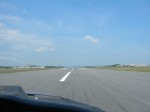
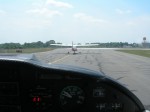
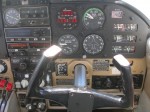
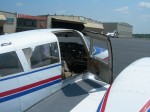
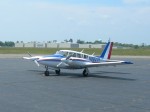
Thanks for sharing the experience. Small aircraft are a hoot, aren’t they? You can really “feel” the performance of the airplane through the seat of your pants.
I quite enjoyed it. In some ways it’s easier than a simulator, because you can feel what you’re doing. In other ways, more difficult, because you can feel what you’re doing :)
NEver had the chance to fly an aircraft, but I can speak from experience ragarding automotive sims. I have issues when I crank the realism all the way up because there is not feedback other than what I get through the forcefeedback mechanisms (which is a small part of the feedback mechanisms in driving a real car).
Wow, I just missed you. I was on the Jersey Shore just a few days ago. Imagine if I’d looked up from my beach towel and saw you barnstorming the surf.
Been flying since 1974. When I first took lessons, I did get a little wobbly after touch down. So much so that I wondered if I could ever be a pilot. I got over it after a bit. I think it has to do with experience and preperation more than anything, but not in a way easily understood. If your head is down and staring at the instruments being discussed by your instructor while in flight, dizzy is sure to follow. However, if you have done all of the book learning before hand, understand what each instrumnet is trying to tell you, and you have thought this out in the simulator, it should be no problem. When your instructor gives you an instruction, or points out an instrument, if you are prepared for a specific lesson (slow flight, turns around a point, stalls, compass heading, VOR, hold patterns, intersections, vectors, etc.) you can digest it quite rapidly if you have done your ground school workout. This quick understanding will allow you to grasp the situational awareness and then give you time to scan the panel as well as look out of the cockpit. If you are unprepared and doing nothing but trying to comprehend the instructor’s lessons and staring at the panel, it will get ugly. Been there, done that.
I hate flying in heavy turbulence but it happens. With experience, in such situations, you can grab a quick scan of the panel to tell you fuel, fuel management, fuel suck, EGT, CHT, HSI, GPS, VSI, RPM, manifold pressure, compass heading, VOR, airspeed, altitude, anticipate your next assigned radio frequency, plan your approach and all of the other neat things you need to know, all the while keeping you eyes out the window 90% of the time. And then, pretty soon, you will master throttle, prop pitch, mixture, gear, flaps and other knobs and dials without ever looking down. There is a reason that they count a pilot’s hours as far as his qualifications go. Time develops these abilities.
In calm weather, and whether or not required, constantly practice your scan of critical instruments. Pretty soon you will be enjoying the view outside instead of applying a death grip to the yoke and fretting over altitude, airspeed and heading.
Definitely go a few more times and see how you feel. Back when I was first learning to drive, I had only been doing a maximum of 35mph until I wound up on Route 1. 45mph, especially surrounded by cars all ignoring the speed limit, felt like I was on one of those g-force simulators NASA uses to train astronauts. Within a month 45mph was abominably slow.
Just remember the most important thing: when signing up for lessons, don’t tell them you don’t care about takeoff and landing.
“In some ways it’s easier than a simulator, because you can feel what you’re doing. In other ways, more difficult, because you can feel what you’re doing :)”
This is pretty much my experience, at least with sims like Microsoft flight Sim. There good for instrument practice, but a bit deficient for VFR flying. Unless you get very large (preferably wraparound) screens, there’s just not enough visual cues to do a lot of maneuvers well. On flight sim, I find my self using a instruments a lot more than I do in a real plane even when I have VFR “weather.” Also, sim landings are harder, because you have no visibility out the sides. In most light planes I’ve flown, the flare attitude is nose high enough that forward visibility is limited for the last few seconds before touchdown. So you have to use the side window to help you judge altitude. BTW, I think the Air Force had the same problem with the Predator Drone when it first came out. Even fighter pilots made hard landings and even crashed because of the lack of visual cues on landing.
Incidentally – one of the most awesome interface decisions made in Falcon 3 was the Padlock view – your POV follows your target. Helped by that being a sim of the F-16 and its bubble canopy.
Flying’s a real gas. I’ve been doing it off and on for nearly 40 years.
You might not want to spend cash on guns and stuff if you get hooked on flying. Trust me on this.
There is no time like right now to get your certificate. Look to AOPA, They used to have a magazine called flight training that you could get a free 6 mo subscription for. They should have a list of flight schools in your area to get you started. Look around for a discovery flight.
Heads up,
Airplanes are more addictive and expensive than machine guns.
Too funny….
Because this Jason’s father-in-law also has a plane.
Your friend Jason’s dad has a nicer plane though. ;-)